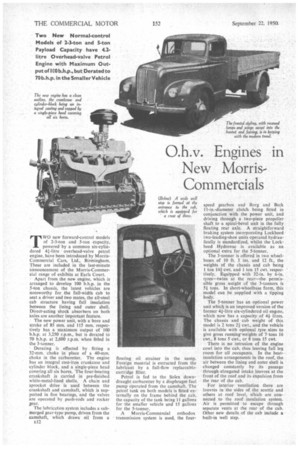0.h4v. Engines in New Morris Commercials
Page 94

If you've noticed an error in this article please click here to report it so we can fix it.
Two New Normal-control Models of 2-3-ton and 5-ton Payload Capacity have 4.2litre Overhead-valve Petrol Engine with Maximum Out put of I CO but Derated to 70 b.h.p. in the Smaller Vehicle TWO. new forward-control models of 2-3-ton and 5-ton capacity, powered by a common six-cylindered 41-litre overhead-valve petrol engine, have been introduced by MorrisCommercial Cars, Ltd., Birmingham. These are included in the last-minute announcement of the Morris-Commercial range of exhibits at Earls Court.
Apart from the new engine, which is arranged to develop 100 b.h.p. in the 5-ton chassis, the latest vehicles are noteworthy for •the full-width cab to seat a driver and two mates, the all-steel cab structure having full insulation between the lining and outer shell. Direct-acting shock absorbers on both axles are another important feature.
The new power unit, with a bore and stroke of 85 mm. and 115 mm. respectively has a maximum output of 100 b.h.p. at 3,250 r.p.m., but is derated to 70 b.h.p. at 2,600 r.p.rn, when fitted in the 3-tonner.
Derating is effected by fitting a 32-mm. choke in place of a 40-mm, choke in the carburetter. The engine has an integral cast-iron crankcase and cylinder block, and a single-piece head covering all six hares. The four-bearing crankshaft is carried in pre-finished white-metal-lined shells. A chain and sprocket drive is used between the crankshaft and camshaft, Which is supported in five bearings, and the valves are operated by push-rods and rocker xear.
The lubrication system includes a submerged gear-type pump, driven from the camshaft, which draws oil from a
al2
floating oil strainer in the sump. Foreign material is extracted from the lubricant by a full-flow replaceablecartridge filter.
Petrol is fed to the Solex downdraught carburetter by a diaphragm fuel pump operated from the camshaft. The petrol tank on both models is fitted externally on the frame behind the cab, the capacity of the tank being 11 gallons for-the smaller vehicle and 15 gallons for the 5-tonner.
A Morris-Commercial orthodox transmission system is used, the four
speed gearbox and Borg and Beck 11-in.-diameter clutch being fitted in conjunction with the power unit, and driving through a two-piece propeller shaft to a spiral-bevel unit in the fully floating rear axle. A straightforward braking system incorporating Lockheed two-leading-shoe units operated hydraulically is standardized, whilst the Lockheed Hydrovac is available as an optional extra for the 54onner.
The 3-tonner is offered in two wheelbases of 10 ft. 3 ins. and 12 ft., the weights of the chassis and cab being ton 141 cwt. and I ton 15 cwt. respectively. Equipped with 32-in. by 6-in. tyres—twins at the rear—the permissible gross weight of the 3-tonners is 5/ tons. In short-wheelbase form, this model can be supplied with a tipping body.
The 5-tormer has an optional power unit which is an improved version of the former 4/-litre six-cylindered oil engine, which now has a capacity of 41 litres. The chassis and cab weight of this model is 2 tons 21 cwt., and the vehicle is available with optional tyre sizes to give gross running-weights of 7-tons 16 cwt., 8 tons 5 cwt., or 8 tons 15 cwt.
There is no intrusion of the engine cowl into the cab, thus leaving full leg room for all occupants. In the heatinsulation arrangements in the roof, the air between the lining and outer shell is changed constantly by its passage through elongated intake louvres at the front of the roof and its expulsion from the rear of the cab.
For interior ventilation there are louvres in the sides of the scuttle and others at roof level, Which are connected to the roof insulation system. Air is permitted to escape through separate vents at the rear of the cab. Other new details of the cab include a built-in well step.




































































































































































































































































